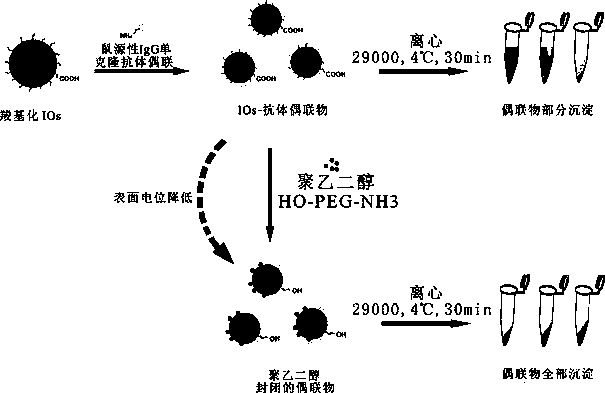Method for purification of conjugate of water soluble nano iron oxide and mouse-origin IgG monoclonal antibody
A kind of iron oxide and water-soluble technology, applied in the biological field, can solve the problems of harsh operating conditions, complicated process, low yield, etc., and achieve the effect of low equipment requirements and simple operation
- Summary
- Abstract
- Description
- Claims
- Application Information
AI Technical Summary
Problems solved by technology
Method used
Image
Examples
Embodiment 1
[0032] Example 1 Synthesis of water-soluble carboxylated iron oxide nanoparticles with amphiphilic polymer as the shell
[0033] At room temperature, 0.1 nmol of FeO(OH), 1.5 mL of oleic acid and 18.75 mL of 1-octadecene were uniformly mixed, and the mixed solution was heated and stirred to 320 °C under nitrogen pressure. When the reaction solution turns from black turbidity to brown transparent, iron carboxylate is formed. When the solution turns black and transparent, ferric oxide (Fe 3 o 4 ) nanocrystal solution formation. To the above ferric oxide (Fe 3 o 4 ) into the nanocrystal solution by adding acetone solution to precipitate iron oxide nanoparticles, and then further purify with chloroform / acetone solution with a volume ratio of 1:10 until iron oxide nanocrystal powder is formed. Take 1 g polystearyl maleic anhydride, 1.2 g 2-(2-aminoethoxy) ethanol and a certain amount of Fe 3 o 4 Crystal powder (Fe 3 o 4 The molar ratio of crystal powder / polymer is 1:10)...
Embodiment 2
[0035] Example 2 This experimental method prepares water-soluble carboxylated iron oxide nanoparticles with a particle size of 8 nm and the coupling and purification process of anti-enrofloxacin monoclonal antibody
[0036] Take 5 mL of carboxylated water-soluble iron oxide nanoparticles with a particle size of 8 nm (concentration: 5 mg / mL) obtained in Example 1 and mix them with an equal volume of 0.05 mol / L borate buffer at pH 6.0; 1-ethyl-(3-dimethylaminopropyl) carbodiimide and N-hydroxysulfosuccinimide with a molar ratio of iron oxide nanoparticles of 150:1 were reacted at 37°C for 2 hours; Anti-enrofloxacin monoclonal antibody solution with a molar ratio of iron oxide nanoparticles of 10:1, adjusted the pH of the solution to 8.0-9.0 with 1 M NaOH solution, and reacted at room temperature for 3 hours; finally added to the solution with a final concentration of 1% Single-end aminated polyethylene glycol (HO-PEG-NH 3 ), and further adjust the pH to 5.0 with 1 M HCl solu...
Embodiment 3
[0037] Example 3 This experimental method prepares water-soluble carboxylated iron oxide nanoparticles with a particle size of 8 nm and is coupled with anti-clenbuterol monoclonal antibody and purification process
[0038] Take 5 mL of carboxylated water-soluble iron oxide nanoparticles with a particle size of 8 nm (concentration: 5 mg / mL) obtained in Example 1 and mix them with an equal volume of 0.05 mol / L borate buffer at pH 6.0; 1-ethyl-(3-dimethylaminopropyl) carbodiimide and N-hydroxysulfosuccinimide with a molar ratio of iron oxide nanoparticles of 150:1 were reacted at 37°C for 2 hours; Anti-clenbuterol hydrochloride monoclonal antibody solution with a molar ratio of iron oxide nanoparticles of 10:1, adjust the pH of the solution to 8.0-9.0 with 1 M NaOH solution, and react at room temperature for 3 hours; finally add the final concentration of 1 %Single-end aminated polyethylene glycol (HO-PEG-NH 3 ), and further adjust the pH to 5.0 with 1 M HCl solution. Centrifuge...
PUM
| Property | Measurement | Unit |
|---|---|---|
| particle diameter | aaaaa | aaaaa |
| particle size | aaaaa | aaaaa |
| particle diameter | aaaaa | aaaaa |
Abstract
Description
Claims
Application Information
 Login to View More
Login to View More - R&D
- Intellectual Property
- Life Sciences
- Materials
- Tech Scout
- Unparalleled Data Quality
- Higher Quality Content
- 60% Fewer Hallucinations
Browse by: Latest US Patents, China's latest patents, Technical Efficacy Thesaurus, Application Domain, Technology Topic, Popular Technical Reports.
© 2025 PatSnap. All rights reserved.Legal|Privacy policy|Modern Slavery Act Transparency Statement|Sitemap|About US| Contact US: help@patsnap.com

